Demographics of Afghanistan
| Demographics of Afghanistan | |
|---|---|
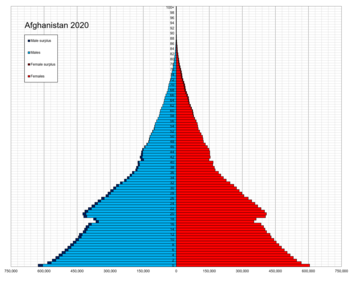 Afghanistan population pyramid in 2020 | |
| Population | 39,864,082 (2021)[1] |
| Growth rate | 2.34% (2016) |
| Birth rate | 38.3 births/1,000 population (2016) |
| Death rate | 13.7 deaths/1,000 population (2016) |
| Life expectancy | 63.2 years (2019)[2][3] |
| • male | 63.3 years |
| • female | 63.2 years |
| Fertility rate | 5.33 children born/woman (2015) |
| Infant mortality rate | 66.3 deaths/1,000 live births[4] |
| Age structure | |
| 0–14 years | 42.3% (male 6,464,070/female 6,149,468) |
| 15–64 years | 55.3% (male 8,460,486/female 8,031,968) |
| 65 and over | 2.4% (male 349,349/female 380,051) |
| Sex ratio | |
| At birth | 1.05 male/female |
| Under 15 | 1.03 male/female |
| 15–64 years | 1.04 male/female |
| 65 and over | 0.87 male/female |
| Nationality | |
| Nationality | noun: Afghan(s) |
| Major ethnic | Pashtun, Tajik, Hazara, Uzbek and others |
| Language | |
| Official | Dari[5] and Pashto |
| Spoken | Dari, Pashto, Uzbeki and other |
The population of Afghanistan is around 39 million as of 2021.[1] The nation is composed of a multi-ethnic and multilingual society, reflecting its location astride historic trade and invasion routes between Central Asia, Southern Asia, and Western Asia. Ethnic groups in the country include Pashtun, Tajik, Hazara, Uzbeks, Nuristanis, Aimaq, Turkmen, Baloch and a number of others which are less known.[6][7][8]
Approximately 46% of the population is under 15 years of age, and 74% of all Afghans live in rural areas.[4] The average woman gives birth to five children during her entire life, the highest fertility rate outside of Africa. About 6.8% of all babies die in child-birth or infancy.[4] The average life expectancy of the nation was reported in 2019 at around 63 years,[2][3] and only 0.04% of the population has HIV.[7]
Pashto and Dari are both the official languages of the country.[5] Pashto is widely used in the regions south of the Hindu Kush mountains and as far as the Indus River in neighboring Pakistan, it is the language with the most native speakers in Afghanistan. Uzbek and Turkmen are smaller languages spoken in parts of the north.[7] Multilingualism is common throughout the country, especially in the major cities. Up to 89.7% of the population practices Sunni Islam and belongs to the Hanafi Islamic law school, while 10–15% are followers of Shia Islam;[7][9] the majority of whom belong to the Twelver branch, with smaller numbers of Ismailis. The remaining 0.3% practice other religions such as Sikhism and Hinduism. Excluding urban populations in the principal cities, most people are organized into tribal and other kinship-based groups, who follow their own traditional customs.
Population statistics[]
Anatol Lieven of Georgetown University in Qatar wrote in 2021 that "it may be noted that in the whole of modern Afghan history there has never been a census that could be regarded as remotely reliable."[10]
Historical[]

The first nationwide census of Afghanistan was carried out only in 1979, but previously there had been scattered attempts to conduct censuses in individual cities.[11] According to the 1876 census, Kabul had a population of 140,700 people.[12] In Kandahar in 1891 a population census was carried out, according to which 31,514 people lived in the city, of which 16,064 were men and 15,450 were women.[13]
In 1979 the total population was reported to be about 15.5 million.[14][15] From 1979 until the end of 1983, some 5 million people left the country to take shelter in neighboring northwestern Pakistan and eastern Iran. This exodus was largely unchecked by any government. The Afghan government in 1983 reported a population of 15.96 million, which presumably included the exodus.[16]
It is assumed that roughly 600,000 to as high as 2 million Afghans may have been killed during the various 1979–2001 wars.[17] These figures are questionable and no attempt has ever been made to verify if they were actually killed or had moved to neighboring countries as refugees.[16]
Current and latest[]
As of 2021, the total population of Afghanistan is around 37,466,414,[7][18] which includes the 3 million Afghan nationals living in both Pakistan and Iran.[19] About 26% of the population is urbanite and the remaining 74% lives in rural areas.[7]
Afghanistan's Central Statistics Organization (CSO) stated in 2011 that the total number of Afghans living inside Afghanistan was about 26 million[19] and by 2017 it reached 29.2 million. Of this, 15 million are males and 14.2 million are females.[20] The country's population is expected to reach 82 million by 2050.[21]
Urban areas have experienced rapid population growth in the last decade, which is due to the return of over 5 million expats. The only city in Afghanistan with over a million residents is its capital, Kabul. The other largest cities in the country are shown in the chart below.
| Rank | Name | Province | Pop. | ||||||
|---|---|---|---|---|---|---|---|---|---|
 Kabul  Kandahar |
1 | Kabul | Kabul Province | 4,273,200 |  Herat  Mazar-i-Sharif | ||||
| 2 | Kandahar | Kandahar Province | 614,300 | ||||||
| 3 | Herat | Herat Province | 556,200 | ||||||
| 4 | Mazar-i-Sharif | Balkh Province | 469,200 | ||||||
| 5 | Jalalabad | Nangarhar Province | 356,500 | ||||||
| 6 | Kunduz | Kunduz Province | 263,200 | ||||||
| 7 | Taloqan | Takhar Province | 253,700 | ||||||
| 8 | Puli Khumri | Baghlan Province | 237,900 | ||||||
| 9 | Ghazni | Ghazni Province | 183,000 | ||||||
| 10 | Khost | Khost Province | 153,300 | ||||||
Age structure[]

0–14 years: 40.62% (male 7,562,703/female 7,321,646)
15-24 years: 21.26% (male 3,960,044/female 3,828,670)
25-54 years: 31.44% (male 5,858,675/female 5,661,887)
55-64 years: 4.01% (male 724,597/female 744,910)
65 years and over: 2.68% (male 451,852/female 528,831) (2020 est.)
Population growth rate[]
2.34% (2021)[7]
country comparison to the world: 39
Urbanization[]
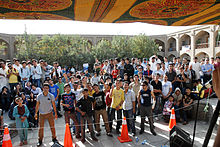
urbanization population: 26% of the total population (2020)
rate of urbanization: 3.37% annual rate of change (2015–20)
Sex ratio[]
at birth: 1.05 male(s)/female
0-14 years: 1.03 male(s)/female
15-24 years: 1.03 male(s)/female
25-54 years: 1.03 male(s)/female
55-64 years: 0.97 male(s)/female
65 years and over: 0.85 male(s)/female
total population: 1.05 male(s)/female (2020)
Vital statistics[]
UN estimates[]
| Period | Live births per year | Deaths per year | Natural change per year | CBR1 | CDR1 | NC1 | TFR1 | IMR1 |
|---|---|---|---|---|---|---|---|---|
| 1950–1955 | 403,000 | 295,000 | 108,000 | 52.9 | 36.9 | 16.0 | 7.45 | 275.0 |
| 1955–1960 | 440,000 | 291,000 | 149,000 | 52.9 | 34.8 | 18.1 | 7.45 | 260.6 |
| 1960–1965 | 488,000 | 295,000 | 192,000 | 52.8 | 32.7 | 20.2 | 7.45 | 245.4 |
| 1965–1970 | 545,000 | 304,000 | 242,000 | 52.6 | 30.3 | 22.4 | 7.45 | 228.1 |
| 1970–1975 | 610,000 | 313,000 | 297,000 | 52.1 | 27.9 | 24.2 | 7.45 | 211.4 |
| 1975–1980 | 657,000 | 307,000 | 350,000 | 51.5 | 25.6 | 26.0 | 7.45 | 194.5 |
| 1980–1985 | 630,000 | 259,000 | 371,000 | 51.8 | 24.1 | 27.7 | 7.45 | 182.8 |
| 1985–1990 | 597,000 | 207,000 | 390,000 | 52.2 | 22.7 | 29.5 | 7.47 | 171.9 |
| 1990–1995 | 714,000 | 210,000 | 505,000 | 52.6 | 21.4 | 31.2 | 7.48 | 161.8 |
| 1995–2000 | 914,000 | 239,000 | 675,000 | 52.4 | 20.1 | 32.3 | 7.65 | 152.3 |
| 2000–2005 | 1,057,000 | 248,000 | 810,000 | 48.4 | 18.3 | 30.1 | 7.18 | 143.7 |
| 2005–2010 | 1,142,000 | 240,000 | 902,000 | 45.1 | 16.8 | 28.3 | 6.37 | 136.0 |
| 2010–2015 | 1,130,000 | 233,000 | 897,000 | 45.1 | 16.8 | 28.3 | 5.26 | 136.0 |
| 2015–2020 | 1,158,000 | 234,000 | 924,000 | 45.1 | 16.8 | 28.3 | 4.41 | 136.0 |
| 2020–2025 | 1,167,000 | 240,000 | 927,000 | 45.1 | 16.8 | 28.3 | 3.71 | 136.0 |
| 1 CBR = crude birth rate (per 1000); CDR = crude death rate (per 1000); NC = natural change (per 1000); TFR = total fertility rate (number of children per woman); IMR = infant mortality rate per 1000 births | ||||||||
| <Source:[23] | ||||||||
Fertility and births[]
Total Fertility Rate (TFR) (Wanted Fertility Rate) and Crude Birth Rate (CBR):[24]
| Year | CBR (Total) | TFR (Total) | CBR (Urban) | TFR (Urban) | CBR (Rural) | TFR (Rural) |
|---|---|---|---|---|---|---|
| 2010 | 35.6 | 5.1 | 34.7 | 4.5 | 35.9 | 5.2 |
| 2015 | 36.8 | 5.3 (4.4) | 35.8 | 4.8 (3.7) | 37.1 | 5.4 (4.6) |
Fertility data by province (DHS Program):[25]
| Province | Total fertility rate (2015) |
|---|---|
| Kabul | 4.6 |
| Kapisa | 4.8 |
| Parwan | 5.7 |
| Wardak | 4.2 |
| Logar | 4.2 |
| Nangarhar | 6.4 |
| Laghman | 7.3 |
| Panjshir | 3.2 |
| Baghlan | 4.4 |
| Bamyan | 5.4 |
| Ghazni | 2.8 |
| Paktika | 5.3 |
| Paktia | 5.2 |
| Khost | 5.6 |
| Kunar | 6.8 |
| Nuristan | 8.9 |
| Badakhshan | 5.3 |
| Takhar | 5.7 |
| Kunduz | 4.4 |
| Samangan | 5.1 |
| Balkh | 5.5 |
| Sar-e Pol | 4.8 |
| Ghor | 5.8 |
| Daykundi | 5.2 |
| Urozgan | 8.8 |
| Zabul | 5.1 |
| Kandahar | 6.5 |
| Jawzjan | 3.9 |
| Faryab | 6.2 |
| Helmand | 4.7 |
| Badghis | 6.6 |
| Herat | 4.8 |
| Farah | 5.4 |
| Nimruz | 5.4 |
Structure of the population[]
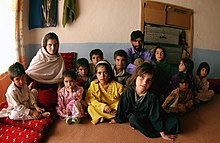
Structure of the population (2012.01.07) (Data refer to the settled population based on the 1979 Population Census and the latest household prelisting. The refugees of Afghanistan in Iran, Pakistan, and an estimated 1.5 million nomads, are not included):[26]
| showPopulation pyramid 2012 |
|---|
| showAge group | Male | Female | Total | Percent |
|---|
Life expectancy[]
total population:
63.2 years (2019)[2][3][27]
country comparison to the world: 214
male: 63.3 years (2019)[2]
female: 63.2 years (2019)[2]
| Period | Life expectancy in Years |
Period | Life expectancy in Years |
|---|---|---|---|
| 1950–1955 | 28.6 | 1985–1990 | 47.7 |
| 1955–1960 | 31.1 | 1990–1995 | 51.7 |
| 1960–1965 | 33.4 | 1995–2000 | 54.2 |
| 1965–1970 | 35.6 | 2000–2005 | 56.9 |
| 1970–1975 | 37.8 | 2005–2010 | 60.0 |
| 1975–1980 | 40.4 | 2010–2015 | 62.3 |
| 1980–1985 | 43.6 | 2015-2020 | 63.2 |
Source: UN World Population Prospects[28]
Development and health indicators[]
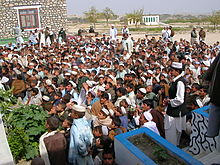
Literacy[]
- Definition: People over the age of 15 that can read and write
- Total population: 43% (2018)[7]
- Male: 55.5%
- Female: 29.8%
School life expectancy (primary to tertiary education)[]
total: 10 years
male: 13 years
female: 8 years (2018)
HIV/AIDS – adult prevalence rate[]
0.04% (2015)[7]
HIV/AIDS – people living with HIV/AIDS[]
Up to 6,900 (2015 estimate)[7][29]
In 2008, health officials in Afghanistan reported 504[30] cases of people living with HIV but by the end of 2012 the numbers reached 1,327. The nation's health ministry stated that most of the HIV patients were among intravenous drug users and that 70% of them were men, 25% women, and the remaining 5% children. They belonged to Kabul, Kandahar and Herat, the provinces from where people make the most trips to neighboring and foreign countries.[31] Regarding Kandahar, 22 cases were reported in 2012. "AIDS Prevention department head Dr Hamayoun Rehman said 1,320 blood samples were examined and 21 were positive. Among the 21 patients, 18 were males and three were females who contracted the deadly virus from their husbands. He said four people had reached a critical stage while three had died. The main source of the disease was the use of syringes used by drug addicts."[32] There are approximately 23,000 addicts in the country who inject drugs into their bodies using syringes
country comparison to the world: 168
HIV/AIDS – deaths[]
Up to 300 (2015 estimate)[7]
Major infectious diseases[]
Degree of risk: high
- Food or waterborne diseases: bacterial and protozoal diarrhea, hepatitis A, and typhoid fever
- Vector-borne diseases: malaria
- Animal contact diseases: rabies
Note: WH5N1 avian influenza has been identified in this country; it poses a negligible risk as of 2009.[citation needed]
Ethnic groups[]
In recent years, a nationwide distribution of Afghan e-ID cards (e-Tazkiras) began. The ethnicity of each citizen is provided in the application. This process is expected to reveal the exact figures about the size and composition of the country's ethnic groups.[33] Article Four of the Afghan Constitution mentions 14 ethnic groups by names but some Afghans belong to other such groups.[6] An approximate distribution of the ethnolinguistic groups are listed in the chart below:

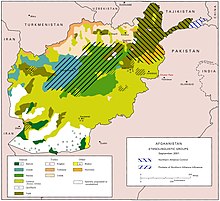
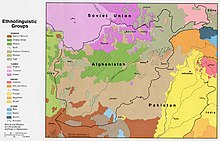
| Ethnic group | Image | Estimate based on Afghan Parliament[34] | 2013 estimate[35] | Pre-2004 estimates[36][37][38] |
|---|---|---|---|---|
| Pashtun | 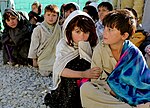
|
38.5% | 42% | 38-50% |
| Tajik/Qizilbash | 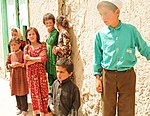
|
21.3% | 27% | 25–26.3% (of this 1% is Qizilbash) |
| Hazara/Sayyid | 
|
24.5% (figure includes Sayyids) | 9% | 12-19% |
| Uzbek | 
|
6% | 9% | 6-8% |
| Aimak | 3.2% | 4% | 500,000-800,000 individuals | |
| Turkmen | 1.2% | 3% | 2.5% | |
| Baloch | 
|
0.5% | 2% | 100,000 individuals |
| Others (Pashai, Nuristani, Arab, Brahui, Pamiri, Gujjar, etc.) | 
|
4.9% | 4% | 6.9% |
The recent estimate in the above chart is somewhat supported by the below national opinion polls, which were aimed at knowing how a group of about 804 to 8,706 local residents in Afghanistan felt about the current war, political situation, as well as the economic and social issues affecting their daily lives. Ten surveys were conducted between 2004 and 2015 by the Asia Foundation (a sample is shown in the table below; the survey in 2015 did not contain information on the ethnicity of the participants) and one between 2004 and 2009 by a combined effort of the broadcasting companies NBC News, BBC, and ARD.[39][40]
| Ethnic group | "Afghanistan: Where Things Stand" (2004)[40] "A survey of the Afghan people" (2004)[39] |
"Afghanistan: Where Things Stand" (2005)[40] | "Afghanistan: Where Things Stand" (2006)[40] | "Afghanistan: Where Things Stand" (2007)[40] | "A survey of the Afghan people" (2007)[39] | "Afghanistan: Where Things Stand" (2009)[40] | "A survey of the Afghan people" (2012)[39] | "A survey of the Afghan people" (2014)[39] | "A survey of the Afghan people" (2018)[39] | "A survey of the Afghan people" (2019)[39] |
|---|---|---|---|---|---|---|---|---|---|---|
| Pashtun | 46% | 40% | 42% | 38% | 40.1% | 40% | 40% | 40% | 37% | 39% |
| Tajik | 39% | 37% | 37% | 38% | 35.1% | 37% | 33% | 36% | 37% | 37% |
| Hazara | 6% | 13% | 12% | 6% | 10.0% | 11% | 11% | 10% | 10% | 11% |
| Uzbek | 6% | 6% | 5% | 6% | 8.1% | 7% | 9% | 8% | 9% | 8% |
| Aimak | 0% | 0% | 0% | 0% | 0.8% | 0% | 1% | 1% | 1% | <0.5% |
| Turkmen | 1% | 1% | 3% | 2% | 3.1% | 2% | 2% | 2% | 2% | 2% |
| Baloch | 0% | 0% | 0% | 3% | 0.7% | 1% | 1% | 1% | 1% | <0.5% |
| Others (Pashayi, Nuristani, Arab, Qizilbash.) | 3% | 3% | 1% | 5% | 2.1% | 3% | 3% | 2% | 2% | 3% |
| Don't know | -% | -% | -% | -% | -% | -% | -% | -% | 1% | -% |
Languages[]
Dari and Pashto are both the official languages of Afghanistan.[5]
Uzbek and Turkmen are spoken as native languages in northern provinces, mainly among the Uzbeks and Turkmens. Smaller number of Afghans are also fluent in English, Urdu, Balochi, Arabic and other languages. An approximate distribution of languages spoken in the country is shown in the chart below:
| Language | Recent estimate including both L1 and L2 speakers[41] | Pre-1992 estimates including both L1 and L2 speakers[36][42][43] | ||||||
|---|---|---|---|---|---|---|---|---|
| Dari | 78% | 25-50% | ||||||
| Pashto | 50% | 50-70% | ||||||
| Uzbek | 10% | 9% | ||||||
| English | 6% | |||||||
| Turkmen | 2% | 500,000 speakers | ||||||
| Urdu | 1% | |||||||
| Pashayi | 1% | |||||||
| Nuristani | 1% | |||||||
| Arabic | 1% | |||||||
| Balochi | 1% | |||||||
| 1 note: data represent most widely spoken languages; shares sum to more than 100% because there is much bilingualism in the country and because respondents were allowed to select more than one language note: the Turkic languages Uzbek and Turkmen, as well as Balochi, Pashayi, Nuristani, and Pamiri are the third official languages in areas where the majority speaks them[41] | ||||||||
Based on information from the latest national opinion polls, up to 51% stated that they can speak or understand Pashto and up to 79% stated that they can speak or understand Dari. Uzbek was spoken or understood by up to 11% and Turkmen by up to 7%. Other languages that can be spoken are Arabic (4%) and Balochi (2%).[39][40]
Religion[]
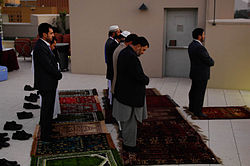
Almost the entire Afghan population is Muslim, with less than 1% being non-Muslim. Despite attempts to secularize Afghan society, Islamic practices pervade all aspects of life. Likewise, Islamic religious tradition and codes, together with traditional practices, provide the principal means of controlling personal conduct and settling legal disputes. Islam was used as the main basis for expressing opposition to the modernization of Afghanistan by King Amanullah in the 1920s. It was also used by the mujahideen during the 1980s Soviet–Afghan War and by the Taliban today.
The members of Sikh and Hindu communities are mostly concentrated in urban areas. They numbered hundreds of thousands in the 1970s but over 90% have since fled due to the Afghan wars and persecution.[45]
- Islam: 99.7% of the total population
- Sunni Muslim: 84.7–89.7%[7][9]
- Shia Muslim: 10-15%[7][9]
- others: 0.3%
| Religion | "A survey of the Afghan people" (2004)[39] | "A survey of the Afghan people" (2006)[39] | "A survey of the Afghan people" (2007)[39] | "A survey of the Afghan people" (2008)[39] | "A survey of the Afghan people" (2009)[39] | "A survey of the Afghan people" (2010)[39] | "A survey of the Afghan people" (2011)[39] | "A survey of the Afghan people" (2012)[39] |
|---|---|---|---|---|---|---|---|---|
| Sunni Islam | 92% | " | 87.3% | " | " | " | " | " |
| Shia Islam | 7% | " | 12.3% | " | " | " | " | " |
| Ismailism | 1% | " | 0.4% | " | " | " | " | " |
| Hinduism | 0% | " | 0.1% | " | " | " | " | " |
| Buddhism | 0% | " | 0% | " | " | " | " | " |
| Sikhism | 0% | " | 0% | " | " | " | " | " |
See also[]
- Culture of Afghanistan
- Turks in Afghanistan
- Tajiks in Afghanistan
- Afghan Turkmens
References[]
- ^ Jump up to: a b https://www.worldometers.info/world-population/afghanistan-population/
- ^ Jump up to: a b c d e "Afghanistan". World Health Organization (WHO). Retrieved 2021-03-01.
- ^ Jump up to: a b c "Afghanistan". United Nations Development Programme (UNDP). 2020. Retrieved 2021-03-01.
- ^ Jump up to: a b c "Afghanistan". uis.unesco.org. Archived from the original on 2017-05-10.
- ^ Jump up to: a b c "Article Sixteen of the Constitution of Afghanistan". 2004. Archived from the original on October 28, 2013. Retrieved July 25, 2012.
From among the languages of Pashto, Dari, Uzbeki, Turkmani, Baluchi, Pashai, Nuristani, Pamiri (alsana), Arab and other languages spoken in the country, Pashto and Dari are the official languages of the state.
- ^ Jump up to: a b "Critics: New Categories on Afghan IDs Will Incite Ethnic Tension". TOLOnews. March 17, 2021. Retrieved 2021-03-17.
- ^ Jump up to: a b c d e f g h i j k l m "Afghanistan". The World Factbook. CIA. Retrieved 2021-03-01.
- ^ Lieven, Anatol (21 April 2016). "What Chance for Afghanistan?". Archived from the original on 22 April 2016 – via www.nybooks.com.
- ^ Jump up to: a b c "Chapter 1: Religious Affiliation". The World's Muslims: Unity and Diversity. Pew Research Center's Religion & Public Life Project. August 9, 2012. Archived from the original on 26 December 2016. Retrieved 4 September 2013.
- ^ Lieven, Anatol (2021). "An Afghan Tragedy: The Pashtuns, the Taliban and the State". Survival: Global Politics and Strategy. 63 (3): 7–36. doi:10.1080/00396338.2021.1930403.
- ^ CENSUS ii. In Afghanistan Encyclopædia Iranica
- ^ (Gazetteer of Afghanistan VI, p. 333).
- ^ Kandahar Newsletter, 10 August 1891, IOR L/P & S/7/63/1295
- ^ "United Nations and Afghanistan". UN News Centre. Retrieved 29 December 2013. Archived October 31, 2013, at the Wayback Machine
- ^ "Chapter 2. The Society and Its Environment" (PDF). Afghanistan Country Study. Illinois Institute of Technology. pp. 105–06. Archived from the original (PDF) on 3 November 2001. Retrieved 12 October 2010.
- ^ Jump up to: a b "Population". U.S. Library of Congress. 2008. Archived from the original on 2011-07-19. Retrieved 2010-10-12.
- ^ "Afghanistan (1979–2001)". Archived from the original on 2011-03-05. Retrieved 2010-10-12.
- ^ "Afghanistan". Worldmeters. www.worldmeters.info. Retrieved 2019-05-30.
- ^ Jump up to: a b Mohammad Jawad Sharifzada, ed. (November 20, 2011). "Afghanistan's population reaches 26m". Pajhwok Afghan News. Archived from the original on January 1, 2013. Retrieved December 5, 2011.
- ^ "Afghan Population 29.2 Million". www.pajhwok.com. Archived from the original on 2017-10-11.
- ^ "Afghanistan – Population Reference Bureau". Population Reference Bureau. Archived from the original on 2013-12-02. Retrieved 2009-12-29.
- ^ "Afghan Population Estimates 1398" (PDF). Central Statistics Organization. 2019. Retrieved 4 July 2019.
- ^ "World Population Prospects: The 2010 Revision". un.org. Archived from the original on 2011-05-06.
- ^ "Archived copy" (PDF). Archived (PDF) from the original on 2014-10-19. Retrieved 2014-06-30.CS1 maint: archived copy as title (link)
- ^ "STATcompiler". www.statcompiler.com. Retrieved 2020-02-17.
- ^ "United Nations Statistics Division - Demographic and Social Statistics". unstats.un.org. Archived from the original on 2016-03-31.
- ^ "Life expectancy in Afghanistan rises past 60 years". Pajhwok Afghan News. November 30, 2011. Archived from the original on May 14, 2012. Retrieved December 5, 2011.
- ^ "World Population Prospects – Population Division – United Nations". Retrieved 2017-07-15.
- ^ "50pc surge in HIV cases, says Dalil". Pajhwok Afghan News. December 3, 2011. Archived from the original on 2013-05-23. Retrieved 2011-12-05.
- ^ Children at risk of contracting HIV/AIDS in Afghanistan Archived 2010-12-30 at the Wayback Machine. December 1, 2008.
- ^ "Over 1,300 HIV cases registered in Afghanistan". Pajhwok Afghan News. December 1, 2012. Archived from the original on May 23, 2013. Retrieved 2012-12-02.
- ^ "AIDS patients have doubled in Kandahar: Official". Pajhwok Afghan News. December 2, 2012. Archived from the original on May 23, 2013. Retrieved 2012-12-03.
- ^ Abasin Zaheer, ed. (May 26, 2013). "Senators stress caution in ID cards issuance". Pajhwok Afghan News. Archived from the original on June 12, 2014. Retrieved 2013-05-04.
- ^ Izady, Michael (2020). "Afghanistan, Ethnic Groups (detailed)".
- ^ https://web.archive.org/web/20131014200908/https://www.cia.gov/library/publications/the-world-factbook/fields/2075.html?countryName=Afghanistan&countryCode=af®ionCode=sas&#af
- ^ Jump up to: a b "The World Factbok – Afghanistan". The World Factbook/Central Intelligence Agency. University of Missouri. October 15, 1991. Archived from the original on April 27, 2011. Retrieved 2011-03-20.
_#_Ethnic divisions: Pashtun 27%, Tajik 46%, Uzbek 9%, Hazara 9%-12%; minor ethnic groups include Chahar Aimaks, Turkmen, Baloch, and other
- ^ "Ethnic Groups". Library of Congress Country Studies. 1997. Archived from the original on 2009-01-10. Retrieved 2010-10-08.
- ^ "PEOPLE – Ethnic divisions". The World Factbook/Central Intelligence Agency. University of Missouri. January 22, 1993. Retrieved 2011-03-20.
Pashtun 36%, Tajik 43%, Uzbek 4%, Hazara 4%-7%; minor ethnic groups include Chahar Aimaks, Turkmen, Baloch, and others
- ^ Jump up to: a b c d e f g h i j k l m n o p See:
- "Afghanistan in 2019 – A survey of the Afghan people". Kabul, Afghanistan: The Asia Foundation. p. 277. Archived from the original (PDF) on 2021-09-15. Retrieved 2021-09-15.
D-14. Which ethnic group do you belong to?
- "Afghanistan in 2018 – A survey of the Afghan people" (PDF). Kabul, Afghanistan: The Asia Foundation. p. 243. Retrieved 2018-12-31.
D-14. WHICH ETHNIC GROUP DO YOU BELONG TO?
- "Afghanistan in 2012 – A survey of the Afghan people" (PDF). Kabul, Afghanistan: The Asia Foundation. p. 182. Archived (PDF) from the original on 2012-11-15. Retrieved 2012-11-28.
Ethnicity Status
- "Afghanistan in 2010 – A survey of the Afghan people" (PDF). Kabul, Afghanistan: The Asia Foundation. 2010. pp. 225–226. Archived (PDF) from the original on 2011-07-19. Retrieved 2011-03-20.
D-9. Which ethnic group do you belong to? SINGLE RESPONSE ONLY Pashtun 48%, Tajik 25%, Uzbek 9%, Hazara 10%, Turkmen 2%, Baloch 1%, Nuristani 1%, Aimak 2%, Arab 2%
- "Afghanistan in 2009: A Survey of the Afghan People" (PDF). Kabul, Afghanistan: The Asia Foundation. Archived (PDF) from the original on 2012-09-07. Retrieved 2012-11-28.
The 2009 survey interviewed 6,406 Afghans (53% men and 47% women)
- "Afghanistan in 2010 – A survey of the Afghan people" (PDF). Kabul, Afghanistan: The Asia Foundation. Archived (PDF) from the original on 2012-09-05. Retrieved 2012-11-28.
The 2008 survey interviewed 6,593 Afghans...
- "Afghanistan in 2007 – A survey of the Afghan people" (PDF). Kabul, Afghanistan: The Asia Foundation. 2010. pp. 225–226. Archived (PDF) from the original on 2011-08-13. Retrieved 2011-03-20.
The 2007 survey interviewed 6,406 Afghans, Which ethnic group do you belong to? SINGLE RESPONSE ONLY Pashtun 55%, Tajik 25%, Uzbek 8%, Hazara 15%, Turkmen 8%, Baloch 1%, Nuristani 1%, Aimak 1%, Arab 1%
- "Afghanistan in 2006 – A survey of the Afghan people" (PDF). Kabul, Afghanistan: The Asia Foundation. pp. 83–88. Archived from the original (PDF) on 2012-04-13. Retrieved 2012-11-28.
A total of 6,226 respondents were surveyed in the study, out of which 4888 (78.5%) were from the rural areas and 1338 (22%) were from the urban areas. Ethnicity: Pashtun 40.9, Tajik 37.1, Uzbek 9.2, Hazara 9.2, Turkmen 1.7, Baloch 0.5, Nuristani 0.4, Aimak 0.1, Arab 0.7, Pashayi 0.3
- "Afghanistan in 2004 – A survey of the Afghan people" (PDF). Kabul, Afghanistan: The Asia Foundation. 2004. Archived (PDF) from the original on 2012-09-06. Retrieved 2012-11-28.
The 2004 survey interviewed 804 Afghans, Which ethnic group do you belong to? Pashtun 40%, Tajik 39%, Uzbek 6%, Hazara 6%, Turkmen 1%, Baloch 0%, Nuristani 1%, Aimak 0%, Arab 1%, Pashaye 0%, Other 1%.
- "Afghanistan in 2019 – A survey of the Afghan people". Kabul, Afghanistan: The Asia Foundation. p. 277. Archived from the original (PDF) on 2021-09-15. Retrieved 2021-09-15.
- ^ Jump up to: a b c d e f g "ABC NEWS/BBC/ARD poll - Afghanistan: Where Things Stand" (PDF). ABC News. Kabul, Afghanistan. pp. 38–40. Archived (PDF) from the original on 2011-06-28. Retrieved 2010-10-29.
- ^ Jump up to: a b "Languages - the World Factbook".
- ^ "AFGHANISTAN v. Languages". Ch. M. Kieffer. Encyclopædia Iranica. Archived from the original on 2011-04-29. Retrieved 2010-10-10.
A. Official languages. Pashto (1) is the language most spoken in Afghanistan. The native tongue of 65-70 % of the population. Persian (2) is the native tongue of 30-35 % of Afghans. Persian is split into numerous dialects.
- ^ "Languages of Afghanistan". SIL International. Ethnologue: Languages of the World. Archived from the original on 2009-01-30. Retrieved 2010-09-18.
- ^ https://www.thearda.com/internationalData/countries/Country_1_2.asp
- ^ "Nearly 99% Of Hindus, Sikhs Left Afghanistan in Last Three decades". TOLOnews. 20 June 2016.
Further reading[]
- Banting, Erinn. Afghanistan the People. Crabtree Publishing Company, 2003. ISBN 0-7787-9336-2.
- Caroe, Olaf (1958). The Pathans: 500 B.C.-A.D. 1957. Oxford in Asia Historical Reprints. Oxford University Press, 1983. ISBN 0-19-577221-0.
- Dupree, Nancy Hatch. An Historical Guide to Afghanistan. 2nd Edition. Revised and Enlarged. Afghan Air Authority, Afghan Tourist Organization, 1977.
- Elphinstone, Mountstuart. 1819. An account of the kingdom of Caubul, and its dependencies in Persia, Tartary, and India: Comprising a view of the Afghaun nation, and a history of the Dooraunee monarchy. Printed for Longman, Hurst, Rees, Orme, and Brown, and J. Murry, 1819.
- Habibi, Abdul Hai. 2003. "Afghanistan: An Abridged History." Fenestra Books. ISBN 1-58736-169-8.
- Hopkins, B. D. 2008. The Making of Modern Afghanistan. Palgrave Macmillan, 2008. ISBN 0-230-55421-0.
- Reddy, L. R. Inside Afghanistan: end of the Taliban era?. APH Publishing, 2002. ISBN 81-7648-319-2.
- Amy Romano. A Historical Atlas of Afghanistan. The Rosen Publishing Group, 2003. ISBN 0-8239-3863-8.
- Vogelsang, Willem. The Afghans. Wiley-Blackwell, 2002. Oxford, UK & Massachusettes, USA. ISBN 0-631-19841-5.
External links[]
| Wikimedia Commons has media related to People of Afghanistan. |
- National Statistic and Information Authority (NSIA)
- Afghanistan - USAID
- Afghanistan – Naval Postgraduate School
- Afghan refugees in Pakistan - UNHCR
- Demographics of Afghanistan